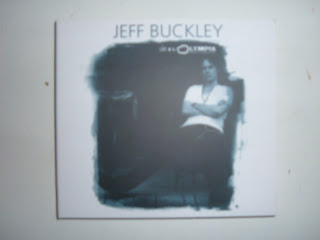For research purposes, I photographed and then analysed some of the Digipacks that I had bought.
A simple dual colour scheme of a dark shade of blue and white, with the artists name and title of the live album - with the main image a picture of the artist himself.
The six panel design of this digipack, when unfolded, shows one panel covered with a large image of the artist, the central panel holding the CD and the right-panel holding a booklet that includes lyrics, pictures and personnel included on the record.
A black and white colour scheme shows the artist name, album title and a picture that extends on to the back panel of the Digipack.
Opening the Digipack shows the inlay has the complete lyrics included on the album along with some small pictures of the band. The panels house a folded poster and the CD itself which is in a plastic case. I thought the use of including a poster within the Digipack was an important aspect as it showed how Media can cross platforms - the artist pictured above has a CD - audio Media, included alongside a poster - Print Media. Both of these carry some similar motifs to show their relation; the poster would include the same typography of that seen on the CD cover for example - whilst the poster would also have an image of Bruce Springsteen shown; the audio will have Springsteen himself singing - Springsteen therefore the motif across media platforms.
A black and white design featuring only the name of the artist - almost an enigma code in itself, in that it is a slightly mysterious picture with simply just a name; this is recognised by the distributor as a sticker containing more information has been plastered on to the top left corner.
An extremely simple design; no pictures, no colours - except black and white - and only the name of the artist on the disc. This design would suggest it's for a mature audience; as someone who has listened to the CD, it could also suggest that the music itself and its subsequent themes have a dark quality about them.
Two different Gatefold packs; a strong image plastered across the inside of the pack with a the CD housed in one of the panels while a booklet containing lyrics and pictures is in the other.
Two different live album digipacks - I used both of these as I felt they contrasted each other; the top digipack is by the alternative band 'Eels', aimed at a mature audience whilst the digipack below it is by the rock band 'My Chemical Romance' - a band aimed at the teenage demographic - similar to our chosen band 'Paramore'.
Opening up both the Digipacks shows how the target audience can influence the design; the 'Eels' have opted for a simple, black colour scheme with one panel detailing the track listing, one including the personnel responsible for making the record possible and the final panel housing the CD. The design on the CD itself is again, simple - a small picture of the lead singer with the header beside it. Small pictures can also be seen on the panels, but are not the main focus of the design, rather more for decoration purposes. In contrast, the digipack below it, 'My Chemical Romance's live album, includes a booklet full of pictures of the band on and off stage. The CD and DVD design feature intricate drawings that reflect the style seen on the bands touring theme, while the panels are all decorated with a background picture of the crowd at the gig featured on the DVD.









No comments:
Post a Comment